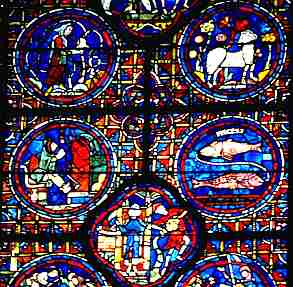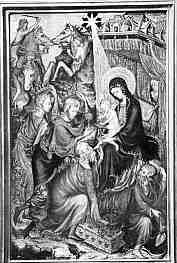

Geoffrey Chaucer

If you are looking at this page without frames, there is more information about medieval writing to be found by going to the home page (framed) or the site map (no frames).
| Works on Astronomy and Astrology (2) | ||||
| By the 12th century, astronomical texts derived from Muslim Spain had been translated into Latin, and contributed to that flow of knowledge that some writers have dubbed the 12th century Renaissance. Later, works of similar nature were recovered from Byzantine sources and funneled through Italy during the course of what rather more writers like to call the Renaissance. Astronomy was part of mainstream literate knowledge. It was possible, by methods of great complexity, to calculate some of the less predictable celestial events, such as eclipses and the movements of planets, including the conjunctions of planets in certain constellations. |  |
|||
| Segment of a 13th century window on the south side of the apse of Chartres Cathedral, showing the zodiac signs and labours of the months. | ||||
| This era also saw the beginnings of the development of scientific instruments for observing and calculating celestial events and time. Mechanical clocks made an appearance in the late 13th century. The astrolabe was an instrument known in antiquity, was developed in the Arab world, and made its appearance in medieval Europe in the 12th century. This was a device with a rotating plate and a star map and assorted moving parts and measuring devices for carrying out various calculations, including the calculation of time based on observations of the sky. | ||||
| Geoffrey Chaucer wrote, or at least translated into English, or compiled in English A Treatise on the Astrolabe, indicating that this kind of knowledge was no longer confined to the rarified atmosphere of the cloisters, but was of interest to lay people reading in the vernacular. |  |
|||
| The text of A Treatise on the Astrolabe can be obtained from Fordham University. An exhibition Epact: Scientific Instruments of Medieval and Renaissance Europe shows some of these and other newfangled scientific instruments of the late medieval and Renaissance period. | ||||
Geoffrey Chaucer |
||||
| While astronomical events had been carefully recorded for their value as portents of events on earth from the early to the late middle ages, the attitude to the church to astrology tended to be a bit enigmatic. It was condemned at various times, along with other forms of soothsaying, but encouraged in certain forms at others. Of course, a trio of astrologers following a bright star in the east was at the heart of the legendary history of the Christian religion, and was much depicted in medieval art. Astronomical events could relate to earthly ones, provided that they were regarded as a sign of God's will, and astrology was not used to, in some way, attempt to dictate to or coerce God into particular actions. |  |
|||
| Half of a diptych of late 14th century English or French origin, depicting the adoration of the Magi complete with their bright star, in the Museo Nazionale, Florence. | ||||
| Whatever the official attitude, astrologers were used, albeit with certain cautions. Kings consulted them to predict the most propitious days for battles or to take other decisive actions. Physicians used them to calulate the time of a patient's death to ensure that, if their largely ineffectual regime of treatments failed, that the patient would receive the last rites before departure. Personal horoscopes were created, based on a person's date and time of birth, to indicate the most favourable times to take actions in their lives. No guarantees on individual events though; that would have been offensive to God and dangerous for the soothsayer. These involved exceedingly complex calculations derived from the computation of genuine astronomical events, and the treatises on the art may have been an attempt to bring the craft of astrology under the authority of the clerical litterati, rather than leaving fortunetelling to illiterate folk practitioners who did not know the theological niceties of the process. The complex knowledge imported with the Arab astronomical texts was put to this use, creating a new class of literature. | ||||
| A collection of very learned electronic texts on medieval astrology can be found at Bibliotheca Astrologica Latina Numerica, from the Warburg Institute. | ||||
| The study of the stars, planets and other celestial phenomena in the middle ages encompassed pragmatic scientific observation, informed by an ancient and developing literary corpus, computed with mathematical complexity, mediated through religion and encompassing what we would today describe as primitive superstition. Still, it was probably based in a sense of awe at the universe, which you can only achieve by going out on a very dark night a long way from the nearest town and looking up for a very long time. Nowadays we look through very large telescopes and fire little peashooter rockets at it and still don't understand what is out there. | ||||
|
|
||||
|
If you are looking at this page without frames, there is more information about medieval writing to be found by going to the home page (framed) or the site map (no frames). |
||||